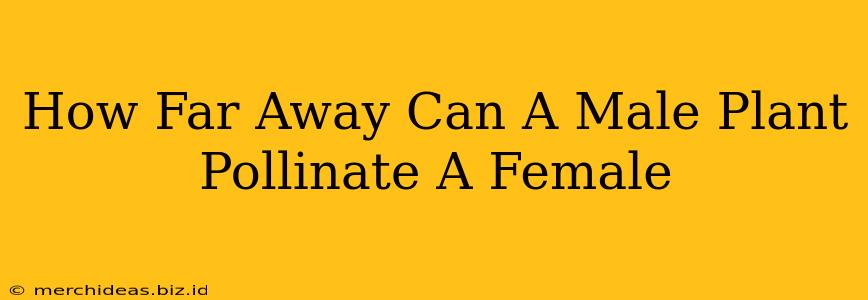The distance a male plant can successfully pollinate a female depends heavily on several factors. There's no single answer, as it varies greatly between plant species and environmental conditions. Let's explore the key influences:
Factors Affecting Pollen Travel Distance
Several factors play a crucial role in determining how far pollen can travel to reach a receptive female flower and successfully fertilize it:
1. Pollen Type and Plant Species:
- Pollen Size and Weight: Heavier pollen grains are less likely to travel far distances compared to lighter ones. Wind-pollinated plants (anemophily) often produce enormous quantities of lightweight pollen to increase the odds of fertilization, leading to greater potential pollination distances. Conversely, insect-pollinated plants (entomophily) might produce stickier, heavier pollen designed for adherence to pollinators, limiting travel range.
- Pollen Viability: Pollen's longevity impacts range. Some pollen remains viable for only a few hours, drastically reducing the distance it can travel and still effectively fertilize. Others maintain viability for days or even weeks, extending the possible pollination distance.
- Plant Species Specifics: Different plant species have evolved unique pollination mechanisms and pollen characteristics, resulting in vastly different effective pollination ranges. Some plants are naturally self-pollinating (autogamy), minimizing distance concerns. Others are highly specialized for cross-pollination, requiring more pollen dispersal.
2. Environmental Conditions:
- Wind: Wind is a major factor for wind-pollinated plants. Strong winds can carry pollen considerable distances, sometimes miles, while calm conditions restrict it to much shorter ranges.
- Water: While less common than wind or insects, water can also aid in pollen dispersal for aquatic plants. Water currents influence the range of pollen dispersal significantly.
- Temperature and Humidity: Extreme temperatures and humidity levels can affect pollen viability, thereby limiting its effective range. Optimal conditions lead to longer pollen viability and potentially longer travel distances.
- Obstacles: Physical barriers like buildings, mountains, or dense vegetation can interrupt pollen dispersal, reducing its effective range.
3. Pollination Method:
- Wind Pollination (Anemophily): As mentioned, this method allows for the greatest potential distance, with pollen potentially traveling hundreds of meters, or even kilometers under the right conditions. Examples include grasses, corn, and many trees.
- Insect Pollination (Entomophily): Insects typically travel shorter distances, resulting in shorter pollination ranges, often limited to the foraging range of the specific insect. Bee-pollinated plants, for example, might experience pollination within a few hundred meters.
- Animal Pollination (Zoophily): Birds, bats, and other animals can contribute to pollination, but their travel distances are variable and plant-specific, much like insect pollination.
Practical Implications and Examples
Knowing the pollination distance of a plant is crucial for many aspects of agriculture and horticulture:
- Crop planning: Understanding pollination distances helps farmers optimize crop spacing and manage pollination effectively.
- Breeding programs: Maintaining genetic diversity relies on knowing the effective pollination distance to prevent unwanted cross-pollination and maintain purity.
- Conservation efforts: Protecting plant populations necessitates understanding pollination limitations, particularly in fragmented habitats.
For example, a corn plant (wind-pollinated) can potentially be pollinated from a significant distance away, potentially hundreds of meters. A tomato plant (insect-pollinated), on the other hand, would have a much shorter pollination radius, usually within a few meters.
Conclusion
The distance a male plant can pollinate a female is not a fixed number. It is a complex interplay of pollen characteristics, plant species, and environmental factors. Understanding these factors is vital for various agricultural and ecological purposes. Further research into specific plant species is needed to provide precise ranges for individual plants.
